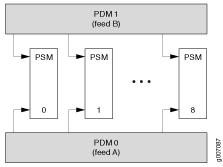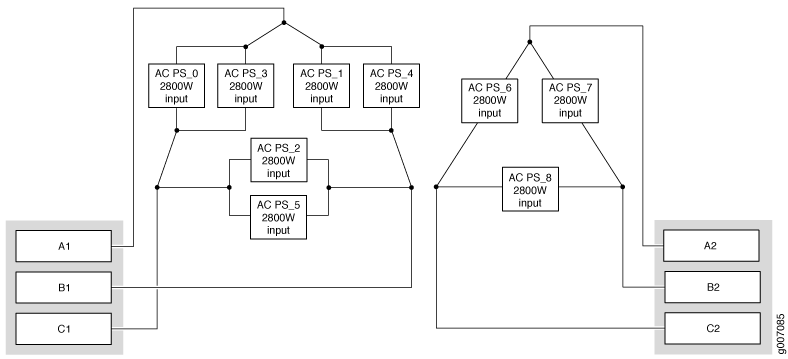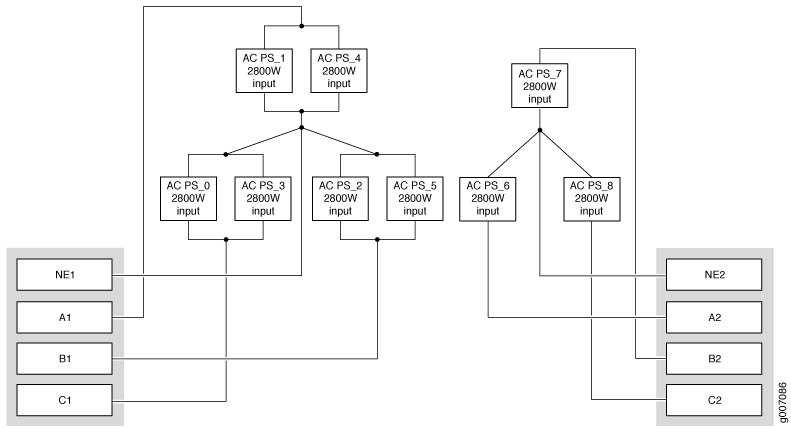MX2010 Component Redundancy
A fully configured router is designed so that no single point of failure can cause the entire system to fail. Only a fully configured router provides complete redundancy. All other configurations provide partial redundancy. The following major hardware components are redundant:
Host subsystem—The host subsystem consists of a combined Control Board and Routing Engine (CB-RE) functioning together. The router can have one or two host subsystems. If two host subsystems are installed, one functions as the primary and the other functions as the backup. If the primary host subsystem (or either of its components) fails, the backup can take over as the primary.
DC power system—The MX2010 DC power system (-48 V and 240 V China) is made up of three components: nine power supply modules (PSMs), two power distribution modules (PDMs), and a power midplane (PMP). For telecom (48 VDC) power supplies the power system distributes power from a pool of 22.5 KW (20 KW for PSM non-redundant and 2.5 KW reserved for PSM redundancy). This pool provides power to ten line-card slots, four fan trays and critical FRUs. These critical FRUs consist of two CB-REs and eight SFBs located in the top portion of the chassis.
DC power feed redundancy—The MX2010 router power system is feed redundant. Each PSM can be connected to two separate feeds from different sources that are used to provide feed redundancy. There are two PDMs per power subsystem that carry nine feeds each. Users should connect feeds from one power source to one PDM and feeds from the other power source to the second PDM of the power subsystem (see Figure 1).
Figure 1: DC Power System Feed Redundancy
Each PSM has a set of two DIP switches located on the faceplate. These DIP switches are used to indicate whether a user wants to connect one feed to the power system, two feeds, or none. These DIP switches provide critical information to the power management system to help generate alarms in case of a feed failure or a wrong connection. Each PDM has an LED per feed indicating whether the feed is active or not, or whether the feed is connected properly. See MX2010 DC Power Supply Module (-48 V) Description.
High-Voltage Second-Generation Universal (HVAC/HVDC) PDMs—The universal PDM accepts either an HVAC or HVDC input. You can install a total of two PDMs into a router. Each universal PDM operates with nine feeds of a 30-A current limit. Each universal PSM is capable of delivering 3400 W of power with-dual feeds and 3000 W of power with a single-feed. In this configuration, each subsystem provides N+1 output PSM redundancy along with N+N feed redundancy. The power feeds from different sources need to be connected to different PDMs. If feeds that connect to one PDM fail in a redundant configuration, the other feed provides full power. For the high-voltage second-generation universal (HVAC/HVDC) power system, both input power feeds are active, and share the load when they are present.
Figure 2 illustrates the power distribution from the universal (HVAC/HVDC) PDMs to the universal (HVAC/HVDC) PSMs.
Figure 2: MX2010 Router Universal (HVAC/HVDC) Power Subsystem Feed Redundancy
AC power system—The MX2010 supports connection of a three-phase AC power system. There are two types of three-phase power systems: the three-phase delta and three-phase wye. The AC power going to the PSMs is split into three individual phases—each PSM works on a single phase. This means the power system works independent of the kind of AC feed is connected. The user can connect one or two feeds, depending on the power system configuration (number of PSMs, redundancy, and so on). Each phase from each of the two feeds is distributed among one or two PSMs (one feed has each phase going to two PSMs, and the other feed has each phase going to a single PSM). See Figure 3 and Figure 4.
Figure 3: Power Distribution from Three-Phase Feed Delta PDM to the AC PSMs Figure 4: Power Distribution from Three-Phase Feed Wye PDM to the AC PSMs
Figure 4: Power Distribution from Three-Phase Feed Wye PDM to the AC PSMs
The AC power system is feed redundant—each PSM takes in two AC feeds and uses one of the two. One AC feed is active at a time. If one feed fails, the PSM automatically switches over to the other feed without disrupting system function (see MX2000 Three-Phase Delta AC Power Distribution Module Description, MX2000 Three-Phase Wye AC Power Distribution Module Description, and MX2000 AC Power Supply Module Description).
AC power requirements—Table 1 shows the MX2010 current requirements for the three-phase delta and wye power feeds.
Table 1: AC PDM Delta and Wye Current Requirements Three-Phase Voltage
Input Feed
Current Delta per Three-Phase PDM
Current Wye per Three-Phase PDM
200 V (minimum–nominal) (line-to-line) for delta (per phase)
1
50 A
–
2
25 A
–
200 V (minimum–nominal) (line-to-neutral) for wye (per phase)
1
–
30 A
2
–
15 A
Note:This is the minimum required to provide 2.5 KW per PSM. Based on facilities guidelines, you should over-provision the MX2010 router. The two numbers listed in the current columns reflect the distribution of phases from the feed to PSM. For example, from one feed each phase goes to two PSMs and from other feed each phase goes to only one PSM.
Power distribution modules (PDMs)—In the DC configuration, each system provides N+1 PSM redundancy along with N+N feed redundancy. The power feeds from different sources need to be connected to different PDMs. If feeds that connect to one PDM fail in a redundant configuration, the other feed starts to provide full power.
Note:Depending on the voltage of the DC feeds (-48 VDC or 240 V China,) power can be drawn from both feeds. The feed with higher voltage provides more power. If the difference between the voltages is sufficient, then the higher voltage feed provides all the power. When the voltages are exactly the same, equal power is drawn from both feeds. For high-voltage second-generation universal (HVAC/HVDC) power system, both input power feeds are active, and share the load when they are present.
A total of two PDMs can be installed into a router. Each DC PDM (-48 V) operates with up to nine separate feeds of either 60-A or 80-A current limit. The capacity of these feeds is relayed to system software through a switch located on the DC PDM. Each DC PDM (240 V China) or DC PDM (-48 V)—operates with nine feeds each. The MX2010 router supports two types of three-phase power system PDMs. The three-phase delta and three-phase wye. Individual phases are taken from three-phase feeds to individual PSMs. One AC feed provides power to six PSMs, while the second input feed provides power to the remaining three PSMs (supporting a total of nine PSMs).
Power supply modules (PSMs)—All nine AC, DC, 240 V China, or universal HVAC/HVDC PSMs in a system share the load. For the high-voltage second-generation universal (HVAC/HVDC) power system, both input power feeds are active, and share the load when they are present. If one PSM fails in a redundant configuration, the remaining eight PSMs provide power to FRUs. Up to nine PSMs might be required to supply power to a fully configured router. Nine PSMs supply power to the two CB-REs (active and redundant), eight SFBs, ten MPCs, and four fan trays (active and redundant).
Cooling system—The cooling system has a total of four fan trays— two per cooling zone (cooling zone 0 and cooling zone 1)—which are controlled and monitored by the host subsystem. Each cooling zone consists of two fan trays. The bottom fan trays are used to cool the bottom half of the CB-REs and SFBs, along with the ten line cards. The top fan trays are used to cool the top half of the CB-REs and SFBs. If a fan fails or the temperature rises above the temperature threshold, the speed of the remaining fans in the zone is automatically adjusted to keep the temperature within the acceptable range (see MX2010 Cooling System Description).
